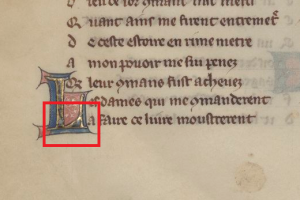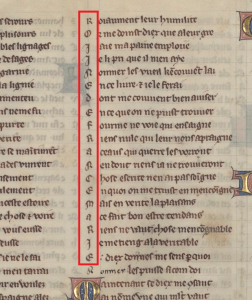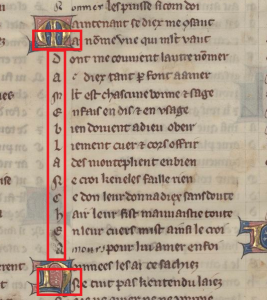In 1274 Marie de Brabant married Philip III of France, and consequently became queen. Even before her coronation the following year she stepped into her role embracing the various forms of influence that came with her new position, including her function as patron of the arts. Considering her lineage and her history, her support for artistic endeavors along with the massive emergence of secular artwork that was infusing France at that time, and most notably the northern parts, should not be surprising.
While researching the various manuscripts she directly or indirectly had her hand in creating I stopped to focus on Paris, Bibliotheque de l’Arsenal, ms. 3142 – a magnificent piece created around 1285, and certainly fit for a queen.
The manuscript reads much like a puzzle where subtle meanings are interspersed across the pages within words and artwork alike, leaving the reader searching for clues. One such precious find exists at the end of the first section where the author, Adenet le Roi, describes the ladies who commissioned the manuscript, Marie and her sister-in-law, Blanche, within an acrostic.
Here are close-ups of folio 71v, the first and second columns (which I have also highlighted for good measure)
This is the bottom of column 1, where the acrostics begin with the champ initial for the line reading “Les dames qui me comanderent / a faire ce livre…” [the ladies who commanded me to make this book…]. Moving downward we have “La”…
Beginning with the top of the second column, as the lofty description of these ladies continues within the text, we get the next words running downwards “roiine de france marie n”…
With the final section beginning with the next champ initial and spelling out “Madame blanche ann” (not to be confused with Blanche d’Artois, Marie’s cousin).
Thus throughout the two columns Adenet le Roi literally spells out and identifies the ladies who commissioned the work as “La roiine de france marie n Madame blanche ann.”
I am not entirely sure how much space this manuscript will receive in my larger project, but I am certainly going to be blogging about it when I find fun little quirks like this.
In fact, the entire page is fantastic and I wish I could dedicate more time to its various details, but if you are curious, you may find the entire manuscripts on the Gallica website, here.








